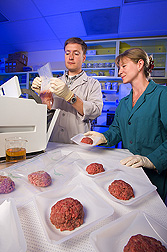This page has been archived and is being provided for reference purposes only. The page is no longer being updated, and therefore, links on the page may be invalid.
Read the magazine story to find out more. |
|
Irradiation for Healthier Food
By Laura McGinnisOctober 30, 2006
Radiation takes a lot of blame for a variety of problems, from sunburn to superhero maladies. But in small doses, it actually contributes to a safer food supply.
Low levels of irradiation can help ensure that U.S. beef producers are providing the safest, highest-quality ground beef products possible. That's the conclusion of Agricultural Research Service (ARS) scientists at the Roman L. Hruska U.S. Meat Animal Research Center (USMARC) in Clay Center, Neb.
Ground beef can pose a serious threat to human health if contaminated by a disease-causing microbe, or pathogen, during grinding. USMARC Director Mohammad Koohmaraie and his colleagues examined the effectiveness of using low levels of radiation on beef carcasses before cutting, to reduce pathogens in ground beef.
High-penetration, high-energy radiation is a safe method of killing bacteria, but it can alter the beef's odor and flavor. Could low-dose, low-penetration electron beam (E-beam) irradiation offer an effective alternative?
The researchers discovered that the low-penetration E-beam reached approximately 15 millimeters (about 1/2 inch) below the surface of the carcass. Because pathogens are most prevalent on the surface, this technology can significantly lower their numbers.
Research also showed that E-beam irradiation effectively reduced pathogens on the carcass surface with little to no influence on the flavor of beef that was used to make stir fry and ground beef products.
Read more about this and other ARS food safety research in the October 2006 issue of Agricultural Research magazine.
ARS is the U.S. Department of Agriculture's chief scientific research agency.

